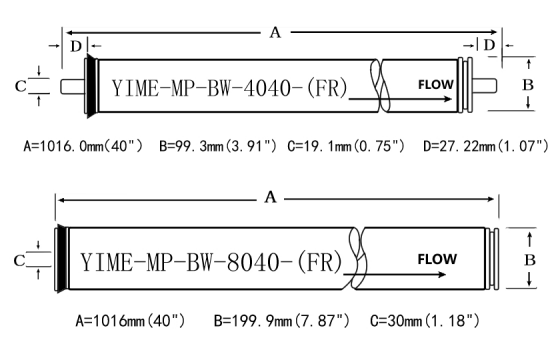Anti-fouling Reverse Osmosis Membrane Product Introduction
The design of the Anti-fouling Reverse Osmosis Membrane aims to provide superior performance compared to traditional membranes while enhancing resistance to membrane fouling. Key improvements include:
- Improved membrane surface roughness
- Enhanced electrical properties of the membrane surface (approaching electrical neutrality)
- Increased hydrophilicity of the membrane material
These advancements significantly boost the membrane's anti-fouling capabilities, reduce the need for chemical cleaning, minimize downtime, and ultimately lower operating costs.
Applications
✅ Pure Water Preparation
✅ Seawater Desalination
✅ Wastewater Treatment
These reverse osmosis membranes are crucial components of RO systems, ensuring reliability, cost-effectiveness, and minimal maintenance in the water treatment process.
🔹 Customization Available! We offer OEM and bulk supply solutions, tailored to meet your specific needs. Contact us via the chat icon for more details.
Performance parameters
|
Model |
Effective Membrane Area (ft² / m²) |
Daily Water Production (GPD / m³/d) |
Stable Salt Rejection Rate (%) |
Operating Pressure
(PSI) |
|
YIME-MP-BW-8040-(FR) |
400 (37.2) |
10500 (39.7) |
99.7 |
225 |
|
YIME-MP-BW-4040-(FR) |
85 (7.39) |
2300 (8.7) |
99.6 |
225 |
Water production floating range:±15%

Membrane Element Dimensions
All units shown in the diagram are in millimeters (mm/inches).
|
Model/Size (mm) |
A |
B |
C |
D |
|
YIME-MP-BW-4040-(FR) |
40.0(1016) |
3.91(99.3) |
0.75(19.1) |
1.07(27.22) |
| YIME-MP-BW-8040-(FR) | 40(1016) | 7.87(199.9) | 1.18(30) |
Note: The dimensions of the membrane element shown in the diagram do not include tolerances.
Standard Testing Conditions:
|
Test Feed Water |
Test Temperature (℃) |
pH Value |
Recovery Rate(%) |
Recovery Rate(%) |
|
2000PPM(Nacl) |
25±5 |
7.5~8 |
15±5 |
5 |
Operating Limits
|
Maximum working pressure |
600psi(4.14MPa) |
|
Maximum water inlet temperature |
45℃ |
|
Maximum water inlet SDI15 |
5 |
|
Maximum residual chlorine concentration(mg/L) |
0.1 |
|
Inlet water pH range during continuous operation |
2-11 |
|
pH range of influent water during chemical cleaning |
1-12 |
|
Maximum allowable pressure drop of a single membrane element |
15psi(0.1MPa) |
Cleaning Procedure for Anti-pollution Reverse Osmosis Membranes
Anti-pollution RO membranes are designed with enhanced resistance to fouling and organic contamination. However, during extended operation, the accumulation of pollutants may still cause a decline in performance. To restore the membrane's flux and salt rejection rate, periodic chemical cleaning is recommended.
Common Types of Fouling & Recommended Cleaning Methods:
| Type of Fouling | Typical Symptoms | Recommended Cleaning Solution |
|---|---|---|
| Organic fouling (biofilm) | Decline in salt rejection and water flow | Alkaline cleaner (pH 10–12) |
| Inorganic scaling (e.g., CaCO₃) | Increase in pressure drop, reduced flux | Acid cleaner (pH 3–4) |
| Iron fouling | Brown or reddish discoloration of membrane | Citric acid / low-pH cleaning solution |
| Colloidal/particulate clogging | Unstable permeate flow, reduced production | Mild surfactant-based cleaners |
General Cleaning Steps:
Prepare the Cleaning Solution:Select the appropriate cleaning chemical based on the type of fouling. Maintain the solution temperature between 25°C–35°C to avoid membrane damage.
Low-Flow Circulation Cleaning:Circulate the cleaning solution through the membrane element at low flow rate for 15–30 minutes to ensure thorough contact with the membrane surface.
Soaking (If Necessary):For heavy fouling, soak the membrane in the cleaning solution for 30 minutes to several hours under static conditions.
Rinsing:After cleaning, flush the system with RO permeate or low-TDS water until the drain water becomes clear and the pH returns to normal.
System Restart:Resume system operation and monitor parameters such as permeate flow, salt rejection, and pressure drop to assess cleaning effectiveness.
Hot Tags: anti-pollution reverse osmosis membrane, China anti-pollution reverse osmosis membranemanufacturers, suppliers, factory, 1000 Gpd Ro Membrane, 3012 800GPD RO Membrane, Industrial RO Membrane MP BW 8040 FR, 1500LPH Pure Water Equipment, Ro Membrane 8040, Ro Membrane 1812 75 Gpd









